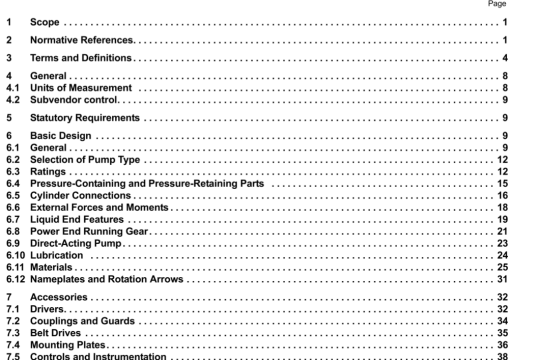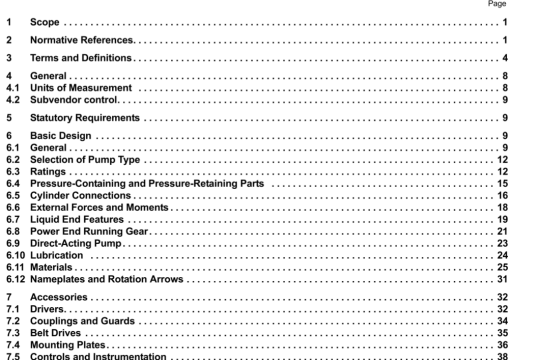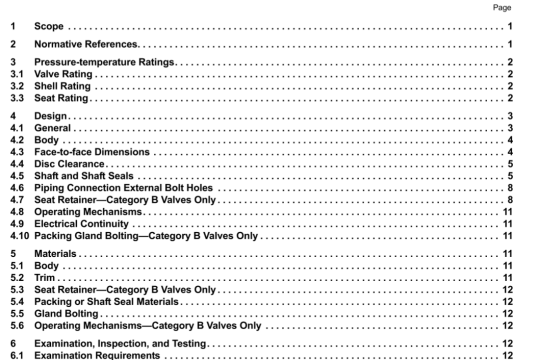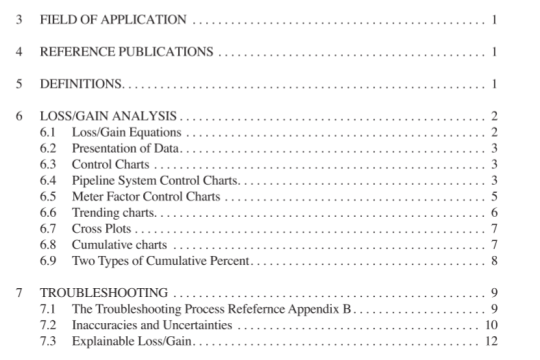API Spec 12P:2008 pdf download
API Spec 12P:2008 pdf download.Specification for Fiberglass Reinforced Plastic Tanks.
4.13 Appurtenances
Nozzles, cleanouts. and other appurtenances shall be installed in accordance with 4.14. Installation laminates shall meet minimum standards shown in Figure Sand Figure 6 of ASTM D3299.
FPR flanged nozzle construction and design shall conform to ASTM D3299, Table 4. Flange drilling and bolting shall conform to ANSI B16.5 for Class 150 flat faced flanges.
All fittings below liquid level shall be remforced Internally with at least two layers of 1.5 oz!ft2 mat. The inner surface shall be sealed according to 4.4.1 of this speCification.
4.14 Walkway, Ladder, Lifting and Hold Down Lugs
The manufacturer shall demonstrate by physical test that all lugs are capable of withstanding two times the allowable service load. The service load for each lifting lug equals the empty weight of the tank. Lugs shall not be installed by the use of fasteners that penetrate the shell. Walkway and ladder loads are specified in Annex B.
It hold-down (wind anchorage) lugs are specified by purchaser, the manufacturer shall use ANSI A58.1 to calculate wind loads. Hold-down lugs shall be placed on the tank so they do not protrude below the bottom surface of the tank.
4.15 Downcomer Pipe
A conductive downcomer pipe shall be installed when specified in the datasheet.
4.16 Thief Hatches
Thief hatch pressure and vacuum ratings shall be in accordance with the design conditions (see 4.1). Bolt patterns shall conform to one of those shown in Figure 4. A grounding lug shall be installed on the thief hatch for grounding purposes, The lug size shall accommodate the attachment of a No. 4 wire, A stnker plate consisting of a minimum of 0.1875 in. x 16 in. 16 in. steel material shall be laminated to the tank bottom directly below the thief hatch,
4.17 Design Considerations for Potential Electrostatic Hazards
The electrostatic hazards which might arise when filling or emptying FRP tanks may be divided into two parts:
1) that due to the accumulation of charge on the outside of the tank:
2) that due to the befd-4Jp of electric field inside the tank.
To minimize the risk in the first type of hazard, it is recommended that the thief hatch be connected to electrical ground. It is also recommended that any metallic walkway, stairway, or ladder attached to an FRP tank be connected to electrical ground.
To minimize risk of the second type of hazard there are several different options to consider. As in metal tanks, the prwnary method utilized to minwmze charge accumulation inside the tanks is to limit flow rates until the filling pipe is covered. The use of conductive metallic downcomers shall also be considered. Conductive tank materials used in tank construction and properly grounded can also be utilized as specified in datasheet. In severe cases the use of a suspended conductor within the tank can be used (see Figure 5).
A.2 Handling
During installation of the tank, several methods of handling are recommended. Tanks may be handled with a crane
utilizing the lifting lugs laminated to the tank.
Caution—Do not attempt to lift by attaching to fitting.
When using cranes for handling, care must be taken to prevent damage to the knuckle radius or to connections by dragging the tank. A tank skid should only be used with a bottom plate to protect the knuckle radius, insuring the base of the tank is setting solidly on the base of the tank skid and is securely fastened to the tank skid by chains or web belting. Care must also be taken when tail boarding with a tank skid that there is sufficient ground clearance for maneuvering the tank on to the grade and that the tank is not severely dropped when set into place. Once the tank is installed on the grade, a final inspection is recommended to ensure that there are no fractures in the base, knuckle, side wall or connections, either in the interior or exterior of the tank. Since the majority of problems with fiberglass tanks tend to occur during handling and shipping, it is strongly recommended that the manufacturer’s spedal instructions be followed in all cases.
A.3 Fire Protection
FRP tanks should be remotely located from any obvious ignition source and or so located that any spill resulting from the failure of these materials could not unduly expose persons, buildings, or structures.




